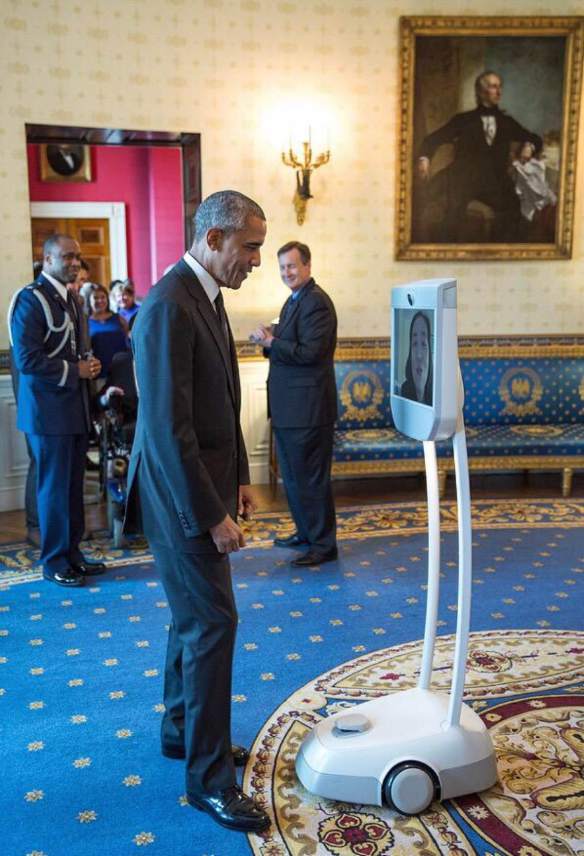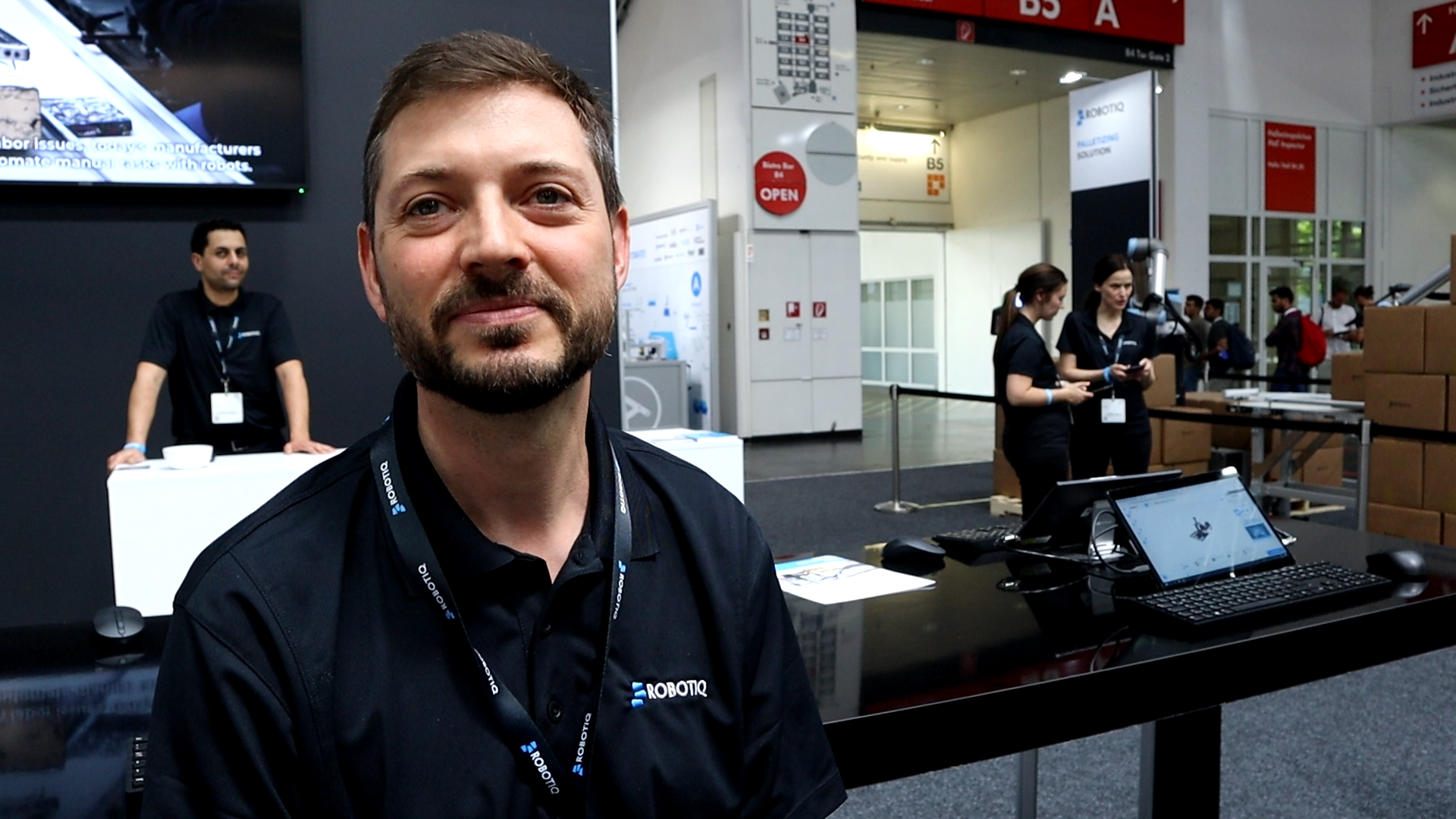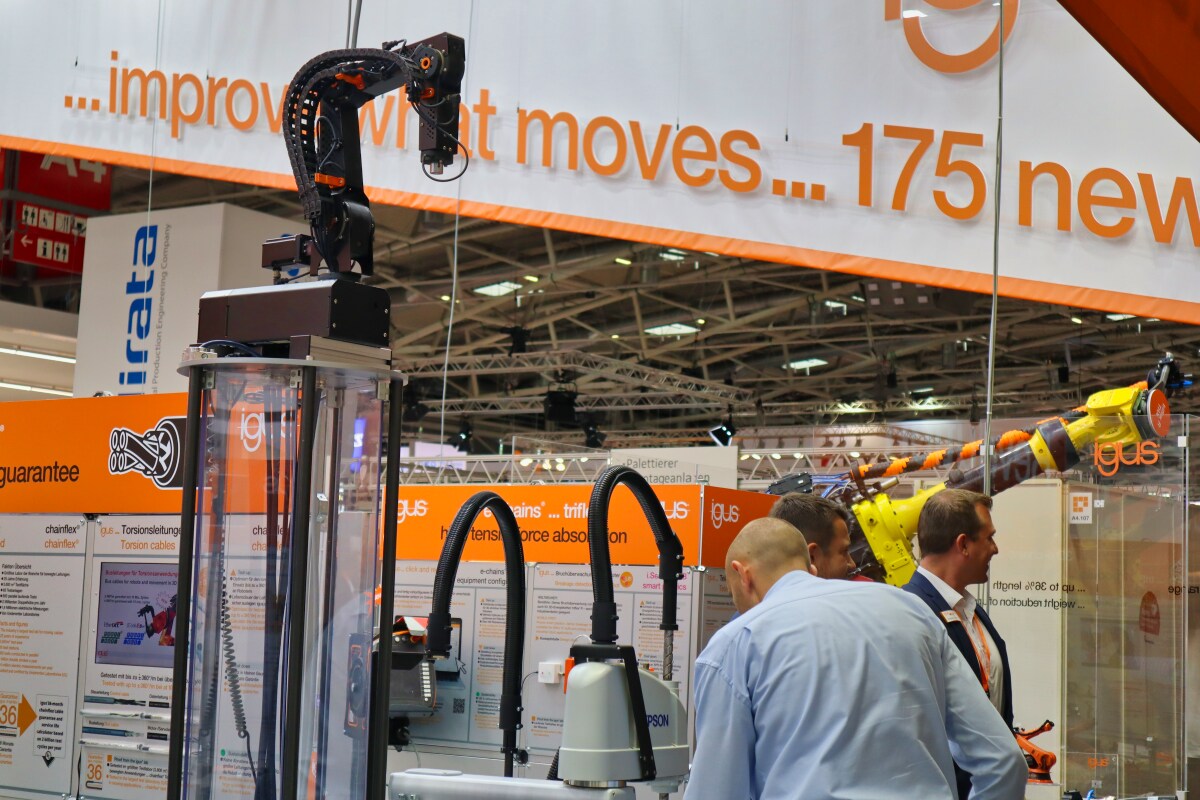Why Telepresence Will Soon Be a $2.5 Billion Industry

People have been slow to adopt telepresence robots, but this could be a sign of their success. Telepresence is not "old news," it's set to be a $2.5 billion industry.

President Barack Obama greets Alice Wong, via Beam Pro. Source : Suitabletech.com
Downstairs in the Robotiq offices, there is an unassuming computer screen. Balanced atop a black stick and wheels, it is not a normal computer monitor. It's a telepresence robot.
Our telepresence robot is pretty useful. It allows members of our team to log in and join meetings when they are traveling away from Quebec. It provides a more realistic experience than normal videoconferencing. It is also our own little piece of an industry that is predicted to be worth $2.5 billion by 2025.
Ten years ago, there was a burst of activity in telepresence when tech giants HP and Cisco joined the industry. Now, thanks to a slow but steady adoption, it looks like telepresence robots are here to stay.
In this article, we'll look at the reasons why telepresence looks set to be a lasting success.
Aren't telepresence robots "old news?"
Of course, telepresence robots are nothing new. We've seen them driving around tech conferences for years now. The ubiquitous Anybot first shipped back in 2010, which — although it may seem hard to believe — was 8 years ago now!
But, it's the fact that they are "old news" that demonstrates their success. When a technology is shiny and new, it's hard to tell if it will stand the test of time. Often, seemingly revolutionary technologies quickly fade into nothingness. Think of the Google Glasses in 2013 which looked set to become an instant success but then were discontinued in 2015 (although Google X has started trying again in 2017 by focusing on industrial use).
By comparison, people have been quite slow to adopt telepresence robots. Some businesses have been concerned about security, others about their financial viability, and others have been skeptical about their usefulness.
However, although adoption has been slow, there is a growing acceptance of telepresence robots by businesses.
Why slow adoption can mean success
According to a recent article in the Robotics Business Review, the industry has not yet reached its full potential due to factors like high costs and a lack of public acceptance. The article explains that telepresence robots are starting to gain traction thanks to lowering prices and better marketing by robot manufacturers.
This all may be true, but I reckon that there's something else going on here. I think that the slow adoption could be part of the normal technology adoption curve.
Many of the groundbreaking technologies in modern business were not instant successes. Companies don't tend to adopt new technologies on impulse. They first try to gauge whether the technology will really help their business, which is quite a slow process.
Researchers have studied technology adoption for the last 60 years. Apparently, it follows an S-shaped curve: there are a few early adopters, followed by a slow adoption by the rest of the industry, and finally the technology becomes the norm as the late adopters also join in. This whole process can take decades. Telepresence is well into that early adopter phase. At Robotiq, we're probably one of the earlier adopters. This makes sense. After all, we are a robotics company!
According to the Telepresence and Videoconferencing Market Report — which is due to be published in October 2018 — this adoption will continue to rise.
We've seen a similar process happen with collaborative robots. At this year's Automatica, we saw that cobots have now well and truly "arrived" in the industry. However, at Robotiq we've been working with them for the past decade.
Often, the slow-adopted technologies are the most successful in the long run.
How do you know that telepresence robots will succeed?
Of course, I don't know for sure that telepresence robots will succeed — nobody does. It's still possible that they will fade into nothingness. However, there is one factor which makes me think that they have the potential to stand the test of time: telepresence robots are a network-led communication technology. Such technologies have been very successful in the past.
In an article for Forbes last year, Charlie Fink explained that the "network effect" has driven a lot of technology adoptions. This is the effect that says "the more people that use a service the more valuable the service becomes."
For example, two of the biggest technologies of the last three decades owe a lot to this effect:
- Personal computers became a huge success once email gained momentum.
- Smart phones became a huge success once messaging and social media apps gained momentum.
Telepresence robots are, in effect, an extension of existing videoconferencing systems. Videoconferencing is a mature industry which is expected to increase its growth rate over the next 5 years.
Some people wonder if telepresence robots are just a gimmick. They question whether they really add something to the videoconferencing experience. However, for those of us who have used a telepresence robot, we know that it's a different experience. It will take time for other businesses to realize this.
What's new with telepresence robots?
Although adoption is slow, developments are being made all the time with telepresence robots. The technology is mature enough that people are starting to try new and interesting things with it.
For example, here are 3 developments that happened very recently:
- Fusion telepresence backpack — Emmet covered this news article in his recent robotics roundup. It's a Japanese robot that effectively gives the user a second pair of arms, which are controlled by a person via telepresence. To be honest, I find this development a bit weird but it is an interesting way to bring manipulation to telepresence robotics.
- Open source telepresence — Back in May of this year, telepresence company OhmniLabs launched its first open source, low cost telerobotic platform. Usually, open sourcing a platform leads to many novel applications of the technology, so this seems like a good thing.
- Catwalk telepresence — What could be a bigger sign of success for a robot than featuring in London Fashion Week? (don't answer that). For some reason, as well as open sourcing their platform OhmniLabs has decided to join up with clothes designer Philipp Plein and drive a telepresence robot down the catwalk this September. I don't know what effect this will have on robot sales but it's certainly a unique way to bring telepresence to the public.
The future certainly looks interesting for telepresence robots!
Do you have a telepresence robot? If not, what is holding you back from getting one? Tell us in the comments below or join the discussion on LinkedIn, Twitter, Facebook or the DoF professional robotics community.






Leave a comment